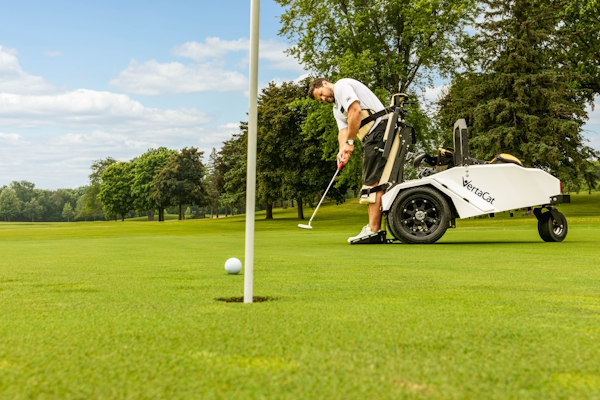Innovative, Adaptive Golf Equipment Enhances Accessibility and Participation for Mobility Challenged Golf Enthusiasts
Jeff Heinz is an orthodontist in Michigan who also happens to be a paraplegic. Jeff has been in a chair for more than a decade, but before his injury he was a high-level golfer who truly enjoyed the game.
“I’ve done it basically since I was five or six years old, so giving that up really broke my heart,” Heinz said. Getting back on the course using innovative adaptive golf equipment, such as an all-terrain mobility rider, has been a game changer for Heinz. “I can’t wait to get back on the course,” he said.
Living with limited mobility
There are many reasons someone may experience limited mobility. Whether due to traumatic injury, amputation, chronic illness, age or any other cause, living with limited mobility can be extremely difficult at any point in a person’s life.
People with limited mobility may encounter a shift in how others see or interact with them. And physical barriers can be additional challenges for those with limited mobility. Everything from buildings without elevators and curb cuts that haven’t been shoveled after snow to adaptive technology that hasn’t yet caught up to the activities people want to participate in – all can be frustrating. Living with limited mobility also puts people at risk of depression and mental health challenges.
However, increased participation in social and physical activities can be greatly beneficial to everyone’s mental and physical health, but particularly for those with limited mobility. Participating in adaptive activities, not only improves a person’s mental and physical health, but boosts self-esteem, reduces stress and increases resiliency.
Accessibility barriers to golf
While great advances have been made in adaptive sports in everything from hockey and cycling to basketball and archery, golf in particular has been a challenging activity to make more accessible.
These difficulties include:
- Poor golf course accessibility
- Golf course policies that make disabled golfers feel unwelcome
- Lack of access to specialized equipment (clubs, teeing devices, carts, etc.) for adaptive golf play
- Limited battery life and instability of some adaptive golf carts
 This golfer is getting back to his game after sustaining an injury that limits his mobility. He is using a VertaCat all-terrain mobility rider to get around the course and land his shots.
This golfer is getting back to his game after sustaining an injury that limits his mobility. He is using a VertaCat all-terrain mobility rider to get around the course and land his shots.When Bob Tidy was
diagnosed with a degenerative neurological disease, he gradually lost his
ability to walk. “I’ve been playing golf since I was about 10 years-old and one
of the worst parts about this disease I have is I can’t play golf anymore,”
said Tidy.
Through his use of a mobility rider, Tidy can now get back on the course in a way that is meaningful for him and has greatly enhanced his life. “It’s terrific for me to get back into the game again,” he said. “I play with my buddies two or three times a week. Adaptive golf equipmentt really brings a lot back into my life."
Making golf more
accessible
Approximately one in every seven Americans played golf in 2022, according to a study by the American Golf Industry Coalition. That’s a 20 percent increase over six years and golf is a sport that is expected to experience continued growth. Additionally, there are an estimated 600,000 disabled golfers in the U.S. and another 6.2 million golfers who left the sport after becoming disabled.
There are specific benefits to participating in adaptive golf, including physical improvements such as balance, endurance and limb strength. Golfing can help patients achieve their goals in physical therapy more quickly. Adaptive golf can also help alleviate anxiety and depression and significantly boost a person’s mental wellbeing.
Making golf facilities more accessible and welcoming to all players is a rising tide that lifts all proverbial boats. Golf is a 100+ billion dollar industry. Golfers travel to visit courses all over the world, purchase homes in proximity to golf facilities and the average American golfer spends between $500 and $1,000 annually on golf equipment.
From making courses more accessible to providing adaptive golf training and onsite specialized equipment, clubs and courses open themselves up to countless new and renewed members.
When clubs and courses expand their adaptive golfing offerings and accessibility to golfers with their own equipment, there is nearly endless revenue potential for the organizations forward-thinking enough to enable golfers of all abilities.
The advantages of adaptive golf are many – whether someone has a life-long disability or played golf their entire life and then experienced circumstances leading to limited mobility. Golfers can utilize innovative adaptive golf equipment to get back on the links. And courses providing innovations in adaptive golf technology can reap the rewards of opening up the sport to new audiences and rekindling the love of golf for those with limited mobility.
-------------
This article on adaptive golf equipment was written by Jeff Nicholson, chief marketing officer for VertaCat mobility rider.
Related Information - Adaptive Golf Equipment
Wheelchair Golf - Overview of Adaptive Golf
Wheelchair Sports Activities
Mobiity Resources
Accessible Travel Resources
Popular ArticlesTypes of Mobility Chairs Wheelchair Sports Activities Helpful Resource Organizations Mobility Scooter Buying Tips Portable Ramp Options |


